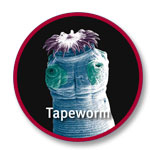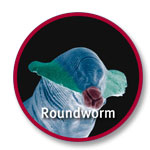Worming
Routine worming protects your cat
Worm your adult cat using our effective, easily administered prescription tablets every 3 months - our prescription treatment treats all known worms. Injectable or "spot-on" versions are available for cats that are difficult with tablets. Kittens should be wormed at 4 weeks, 8 weeks, 12 weeks and 16 weeks, then every 3 months throughout life.
Worming - what NOT to use
Many old-fashioned wormers still on general sale are ineffective or have side effects. Some cheap tapeworm tablets still use dichlorvos which can cause convulsions and vomiting, especially in cats.
About roundworms
About tapeworms
 Some tapeworms are transmitted by fleas.The cat, irritated by the flea, grooms itself and eats the flea. In the bowel the flea is digested releasing the tapeworm to develop in the gut.
Some tapeworms are transmitted by fleas.The cat, irritated by the flea, grooms itself and eats the flea. In the bowel the flea is digested releasing the tapeworm to develop in the gut.
Other tapeworms are transmitted by eating uncooked meat, hunting or scavenging. Adult tapeworms develop in the gut. Tapeworm segments are passed in the cat's faeces and are eaten by birds and mice. The tapeworms form cysts in the muscles of these small animals and remain dormant until the flesh is eaten by a dog or cat. The cysts then develops into tapeworms in the gut. Tapeworm segments like tiny slugs or dried up grains of rice may be seen near the anus, or lengths of tapeworm may be "washed out" by diarrhoea. Untreated cats may show no signs of worms, but if they become ill for some other reason they will deteriorate more quickly because of the debilitating effects of the worms.
Useful link for more information http://www.wormpatrol.co.uk/
.jpg) 30 years ago..... (David Higginson MRCVS remembers)
30 years ago..... (David Higginson MRCVS remembers)
Barely a day would go by without a cat passing worms in the consulting room. Thin, wormy kittens would vomit up a tangled mass of roundworms, scrawny tom cats would have tapeworm segments all crawling all around their bottoms. These days such heavy worm infestation are less common. Cats that hunt still present us with lots of tapeworms, especially in late summer. The introduction of Milbemax within the last few years has revolutionised worming in cats as it is totally effective against all types of worm. 25 years ago we'd never heard of dermatitis and bowel inflammation caused by allergies to worms.

 Roundworms produce thousands of tiny eggs which are passed in the faeces and lie dormant on the ground. These eggs are transmitted directly to other cats as they sniff and lick around. They even re-infect the host cat directly as he licks his own rear end. Roundworms will often be vomited up by kittens, but in adult cats there may be no clues to indicate that roundworms are present. They will still be there, draining the body's resources and triggering allergies.
Roundworms produce thousands of tiny eggs which are passed in the faeces and lie dormant on the ground. These eggs are transmitted directly to other cats as they sniff and lick around. They even re-infect the host cat directly as he licks his own rear end. Roundworms will often be vomited up by kittens, but in adult cats there may be no clues to indicate that roundworms are present. They will still be there, draining the body's resources and triggering allergies.